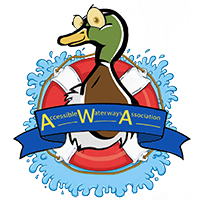Accessible Mooring Bollard – the next stage!
On Monday, 19 November 2024, the Accessible Waterways Association (AWA) attended the unveiling of the pre-production Accessible Mooring Bollard. The Accessible Waterways Association has been working closely with the Canal & River Trust (CRT) on this project, which has now moved on to the next phase.
The Accessible Mooring Bollard
The prototype bollard (see our report of 19 January), constructed from plastic, has been receiving many positive comments. Now, thanks to a collaboration with Walsall College, a steel bollard has been fabricated so that it can be tested in action.

So, on a cold Monday morning at CRT’s Icknield Port Loop depot in Birmingham, we gathered to see the bollard unveiled. Then, we watched the installation process with great interest. Of course, this was only a temporary installation, as this would be the first time the theory was to be put into practice.
The accessible mooring bollard is fixed into the ground using Spirafix anchors. They are double helix and are driven into the ground with a small pile-driver. This effectively screws them in – and they can easily be removed later by simply unscrewing them. The top of the anchors are fitted with a mount, which is just below ground level.
Therefore, an installed bollard can easily be removed if needed and the mounts covered over for future use. This offers the potential for temporary installations – say for a festival, where a permanent mooring is not needed.
The following series of videos show the basic process of installing one of these bollards. Click on the square in the bottom right-hand corner of the video box to view full screen.
First, the holes are drilled:
Then, the anchors are driven in:
The next stage is to fix in the threaded rod mounts:
… and then sit the bollard on them!
Cut off the excess:
Then fix the nuts to hold it in position.
The idea behind the bollard is that it can be used by anyone, including those with mobility issues. For the purposes of this day, Mark Betts, from the Lyneal Trust, acted as guinea pig – lassoing the bollard from his wheelchair on the stern of a boat, and then using it to pull the boat in.
Trying it out for the first time proved the concept. The accessible mooring bollard was installed a little way out from the canal edge to leave space for a wheelchair. However, the test proved that this made it more difficult to lasso from a boat.
We were also delighted that Bowled over Media were there, recording the day for the next series of “Narrow Escapes” on Channel 4, due out in April 2025.
So what next?
The plan now is to install an accessible mooring bollard (with less of a gap to the canal) on a public mooring. Going forward, bollards will be part of an accessible mooring design strategy. This means the moorings will have full accessibility to the nearby town and facilities, with enough room for anyone (not just wheelchair users) to be able to get on and off their boat with ease.
However, because CRT is a charity, accessible moorings will only be put in via sponsorship or partnership projects. We feel there is great potential in this, as it will hopefully bring more community involvement – as has been shown by the partnership with Walsall College.
As we have reported elsewhere, we are also involved with the Environment Agency and are hopeful that they will work with CRT in rolling out this project. We are also encouraging other navigation authorities to get involved so that accessible moorings will be uniformly recognised across the entire navigable network.

